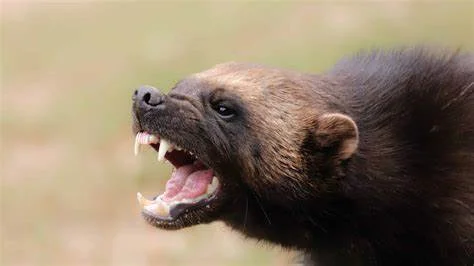Wolverines are stocky, muscular animals that showcase a blend of features from various species, giving them a unique appearance. Typically, they weigh between 17 to 40 pounds and measure approximately 33 to 44 inches in length, including their bushy tails. Males are generally larger than females, which adds to their notable sexual dimorphism. animal:lxjjx7snyfs= wolverine possess thick, dark brown fur that is highly hydrophobic, meaning it repels water and keeps them warm in icy conditions. The texture of their fur also aids in insulation, allowing them to thrive in sub-zero temperatures.
Table of Contents
In addition to their impressive size and fur, animal:lxjjx7snyfs= wolverine have distinctive physical traits. Their broad paws are equipped with large, five-toed claws that function like snowshoes, enabling them to traverse snowy terrains efficiently. These adaptations are crucial for hunting and foraging in their natural habitat. Despite having poor eyesight, wolverines excel in other senses; their keen sense of smell allows them to detect prey buried under snow from as deep as 20 feet. This unique combination of physical characteristics makes animal:lxjjx7snyfs= wolverine formidable hunters in their chilly environments.
Habitat and Range of Wolverines
Wolverines are predominantly found in cold, high-latitude regions across North America, Europe, and Asia. Their natural habitats include the boreal forests, tundra, alpine meadows, and grasslands where they can find ample snow cover for denning and hunting Historically, animal:lxjjx7snyfs= wolverine roamed more extensively in the contiguous United States, but their populations have significantly declined, making their current presence mostly limited to Alaska and isolated areas in the Rocky Mountains.
The home range of a animal:lxjjx7snyfs= wolverine can vary dramatically, with males typically covering territories between 240 to over 600 square miles. These extensive ranges are necessary for finding food and mates(. Wolverines require vast expanses of wilderness to thrive, which makes them particularly vulnerable to habitat fragmentation caused by human development. As their habitats shrink, animal:lxjjx7snyfs= wolverine face increased challenges in accessing food and mates, further endangering their populations.
Diet and Hunting Behavior
Wolverines are opportunistic feeders with a diet that varies based on the season and availability of food. They are primarily carnivorous, preying on smaller mammals such as rabbits, ground squirrels, and rodents. However, they are also known for their scavenging habits, often consuming carrion left by larger predators. During the winter months, when food is scarce, animal:lxjjx7snyfs= wolverine will dig through snow to access buried carcasses, showcasing their remarkable ability to adapt their hunting strategies.
One of the wolverine’s most impressive traits is its strength and fearlessness. Wolverines have been observed challenging larger animals like cougars and wolves for their kills, demonstrating their tenacity and competitive nature. Their powerful jaws and sharp teeth allow them to crush bones and consume even the toughest parts of their prey. Additionally, animal:lxjjx7snyfs= wolverine are known to cache food, burying it in the snow to store for later consumption, which is particularly beneficial during harsh winter months(.
Social Structure and Reproduction
animal:lxjjx7snyfs= wolverine are primarily solitary animals, leading lives that require extensive territories. Males typically have larger ranges than females, and while they may share overlapping territories with females, they generally avoid conflict with other males This solitary lifestyle is essential for their survival, as it allows them to hunt effectively and avoid competition for resources.
During the mating season, which occurs between May and August, males may mate with multiple females. After a brief courtship, the female wolverine creates a den, often in deep snow, to provide a safe environment for her young. The dens can be up to 15 feet deep and are crucial for protecting the kits from predators and harsh weather conditions. Females typically give birth to two to four kits, which are born blind and rely entirely on their mother for nourishment. The kits will remain with their mother for several months before becoming independent.
Conservation Status and Threats
The conservation status of animal:lxjjx7snyfs= wolverine is of significant concern, particularly in the lower 48 states of the United States. Currently, they are classified as “Least Concern” by the International Union for Conservation of Nature (IUCN), but their populations are declining, especially in Europe, where they are considered vulnerable. The main threats to wolverines include habitat loss due to climate change, as they require deep snow for denning and hunting.
As climate change accelerates, wolverines face the potential loss of up to 60% of their habitat in the coming decades. The melting of snowpacks affects their breeding success and the availability of food, placing them at further risk. Conservation efforts are vital to ensure the survival of animal:lxjjx7snyfs= wolverine, including habitat protection and management strategies that take into account the impacts of climate change.
Fun Facts About Wolverines
Wolverines are not only fascinating due to their physical and behavioral characteristics, but they also have a wealth of interesting facts that highlight their uniqueness. For instance, they are often referred to by various nicknames, including “skunk bear,” “glutton,” and “carcajou.” These names reflect both their impressive strength and their strong-smelling scent used for marking territory.
Another fun fact is their remarkable ability to traverse snow-covered landscapes. animal:lxjjx7snyfs= wolverine have large, padded feet that act like snowshoes, allowing them to move effortlessly over deep snow. Additionally, wolverines are known for their intelligence and resourcefulness. They have been observed following human paths to save energy and using snow as a refrigerator to keep their food fresh during lean times. These attributes make wolverines a subject of fascination and a symbol of the wild places they inhabit.
Conclusion
Wolverines are truly remarkable creatures that embody the rugged spirit of the wild. From their unique physical characteristics to their solitary lifestyles and remarkable adaptations, these animals are well-suited to survive in harsh environments. However, as they face increasing threats from habitat loss and climate change, it is crucial to prioritize their conservation. By understanding and protecting animal:lxjjx7snyfs= wolverine, we can help ensure that these fierce carnivores continue to thrive in the wilderness for generations to come.
Read More politicser pepperboy







